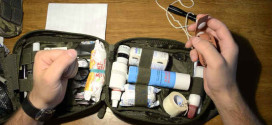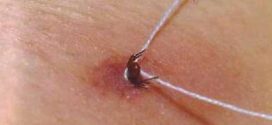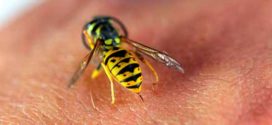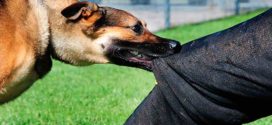Cases of injuries associated with injuries and violations of the skin are not uncommon both in hunting or fishing, and in everyday life. Therefore, each of us is simply obliged to have at least some knowledge about the rules for providing first, elementary medical / aid to the victim. We will figure out what needs to be done immediately and how to provide first aid for wounds and bleeding.
An article replete with medical terms and specific details is unlikely to be of interest to the reader. Mainly for the reason that such material is incomprehensible to an unprepared professional person. Therefore, the author considers it appropriate to dwell only on the main aspects of the problem, the knowledge of which will really be useful in practice and will be clear to everyone.
Depending on the type, degree of damage and characteristics of the organism, the symptoms manifest themselves in different ways. Therefore, only a thorough analysis of all the signs, their comparison allows us to draw the right conclusion and determine exactly how to proceed.
The main signs of internal bleeding
It makes no sense to talk about external bleeding - it is clearly visible. Naturally, we are not talking about a small scratch with the appearance of 1 - 2 drops of blood. But her internal bleeding is a rather complicated issue. The main danger is that the consequences of injuries may not appear immediately, but only after some time.
To make first aid as effective as possible, you should know the main symptoms of bleeding:
- General weakness, dizziness, sometimes nausea, caused by no one knows what. The victim does not always experience pain in the affected area. It depends both on the characteristics of the human body and the specifics of the injury (wounds, burns, and so on).
- The desire to take a certain (closed) posture. For example, if the lesion is in the peritoneal region, then the victim involuntarily pinches this place with his hand or tries to “fold”, trying to minimize pain.
- Progressive pallor (primarily of the face), cold sweat (perspiration).
- Rapid pulse, decreased blood pressure.
- Partial visual impairment (appearance of "flies", blurry "pictures"), feeling of thirst (dryness in the oral cavity).
First aid
- Help the victim to take the “semi-sitting” position (legs at the knee joints are slightly bent).
- Press something cold against the peritoneal area (ice from the freezer wrapped in a cloth; a vessel with water, and so on, according to circumstances).
- Immediately call an ambulance or independently deliver a person to any medical / institution.
Types of external bleeding
Arterial
sign - blood flowing profusely from the wound. The jet is pulsating, mostly scarlet in color. First aid - stop bleeding. When it comes to limbs, a twist or tourniquet is used for this.An option (in the absence of the necessary material at hand) is to pinch the artery just above the wound with your finger and call someone for help. Until a tourniquet is applied, the pressure on the blood vessel cannot be relieved. If you can’t cope on your own (for example, if you don’t have the necessary material at hand), then you definitely can’t do without an assistant. That is why, having noticed profuse bleeding in the victim, it is advisable to immediately send a “distress signal”. Otherwise, precious time may be lost.
Rules for applying a tourniquet
This method of stopping blood flow is practiced only if all the others are unacceptable for some reason. For example, with heavy bleeding. As with any medical practice, the use of a tourniquet often leads to negative consequences or has an undesirable side effect. Therefore, this method of assistance should not be abused.
- The application is made on top of clothing, and always above the damaged area.
- This must be done quickly, since the main purpose of using a tourniquet is to instantly stop bleeding. Various “fittings” are in principle unacceptable, since sometimes seconds count. The limb is raised, a couple of turns are made, and the ends are fixed.
- If everything is done correctly, then the pulse should not be felt on the leg or arm, and the bleeding stops. After the assistance provided in this way, it is necessarily controlled.
- The tourniquet at the place of application can be kept in a fixed position only for a certain time (in hours): in summer - no more than 2, in winter - up to 1. Otherwise, the process of tissue death may begin. Therefore, after the specified period, the tourniquet is weakened for 6-8 minutes and shifted slightly higher, after which it is tightened again. During this time, the artery is clamped with a finger so that bleeding does not resume.
- At the end, a bandage is applied to the bleeding site, which simultaneously performs an antiseptic function and protects the wound from the penetration of dirt, dust, microorganisms, and so on.
What to consider:
- It happens that the person who provided first aid cannot wait for the paramedic to be called. In this case, you need to leave a note in which to note the exact time the tourniquet was applied.
- If the "screed" is shifted several times (for example, delivery to a medical/institution takes a long time), then the intervals between fixations should be reduced. That is, before the first weakening of the tourniquet - 2 hours, before the second - no more than 1, the third - 0.5. Otherwise, there is a risk that normal blood flow may not be restored.
- As a medical tourniquet, in the absence of one at hand, you can use an elastic (rubber) tube (hose), a scarf, a cloth tape, a tight bandage, a belt, a tie, or something similar. The main thing is not to waste time searching.
- It is advisable to regularly massage the limb on which the tourniquet is applied or twisted.
Venous bleeding
sign The color of blood is dark red. Its jet is relatively even, of medium intensity. First aid - pressure bandage. It is applied to the damaged area, while the limb is bent at the joint and rises slightly. With venous bleeding, the tourniquet is not used!A tampon is applied to the site of bleeding. A bandage folded in several layers, a piece of gauze. If blood begins to appear through the bandage, everything repeats - a tampon, a bandage.
capillary bleeding
sign - in this case, the bleeding is insignificant, and is observed not only at the site of the formation of the wound, but also in a small area around it. First aid - the same pressure bandage with a preliminary overlay of a piece of clean matter. You can use a folded bandage, gauze, even a handkerchief (if it's fresh).All of these methods of stopping bleeding are temporary. Therefore, it cannot be limited to this alone. In most cases, you need to see a specialist. Only he can make a final conclusion about the effectiveness of first aid, the feasibility of further measures and the need for preventive procedures. For example, anti-inflammatory injections and the like.
about how to help with an animal bite here .
Nose bleed
It is observed quite often, and not only after a blow to the face. For example, with blowing your nose, a strong sneeze, sometimes as a result of a cranial injury.
First aid:
- Pinching of the wings of the nose.
- Placement in the nostrils of soft swabs. In the absence of hydrogen peroxide, they can be lightly moistened with clean water.
Bleeding in the neck and head
It has its own specifics of independent provision of emergency medical care. It is necessary to clearly understand where the artery (blood vessel) is located, which must be clamped depending on the site of the lesion.
What to consider:
- The corresponding artery is pressed, which is located on the side where the wound is.
- Blood is pumped through the vessels by the heart. Therefore, the place for pressing the finger should be between it and the wound, closer to the latter.
First aid for injury
The only thing a non-professional in terms of first aid can do here is stop the bleeding. Everything else is the field of medicine. Any intervention, even with the best of intentions, can lead to negative and sometimes fatal consequences. Therefore, it is more correct to focus on what is unacceptable.
Do NOT in case of injury
- Touch the damaged area, try to clean it, rinse it, and even more so make attempts to remove foreign objects (a piece of wire, wood chips, a fragment, a bullet, and so on).
- Independently change the existing bandage. With heavy bleeding, you should only apply another one from above, and wait for the arrival of a professional doctor.
- If the wound is in the sternum: give the victim food or liquid, no matter how he asks to drink or eat; talk to him.
Hello, I am Alexander, the mastermind behind the blog.
In terms of career and free time, I connected my life with the forest. How else, when you live in Karelia! In this blog, I am responsible for the hunting, hiking and equipment sections. Welcome to my world!
 Survival Lessons Tips for the survivalist, fisherman and hunter
Survival Lessons Tips for the survivalist, fisherman and hunter



